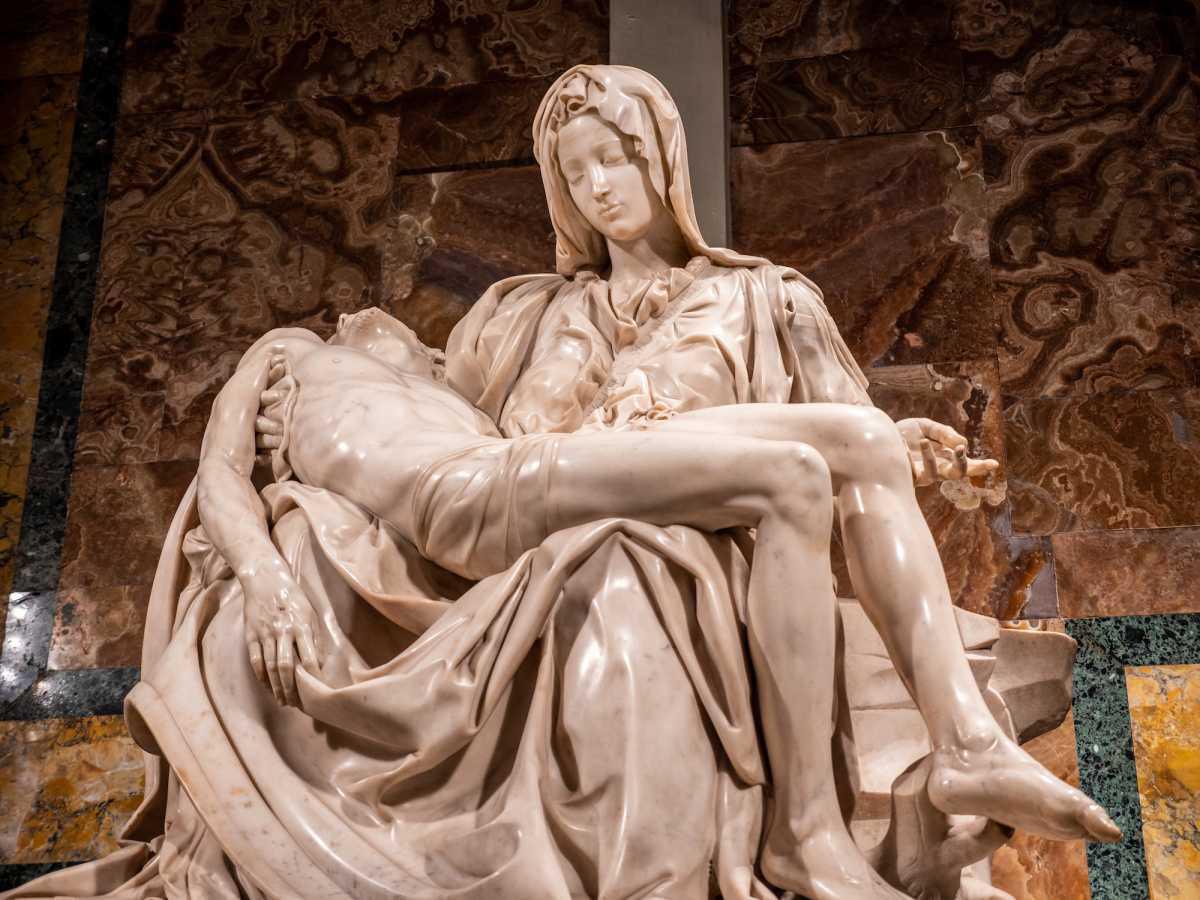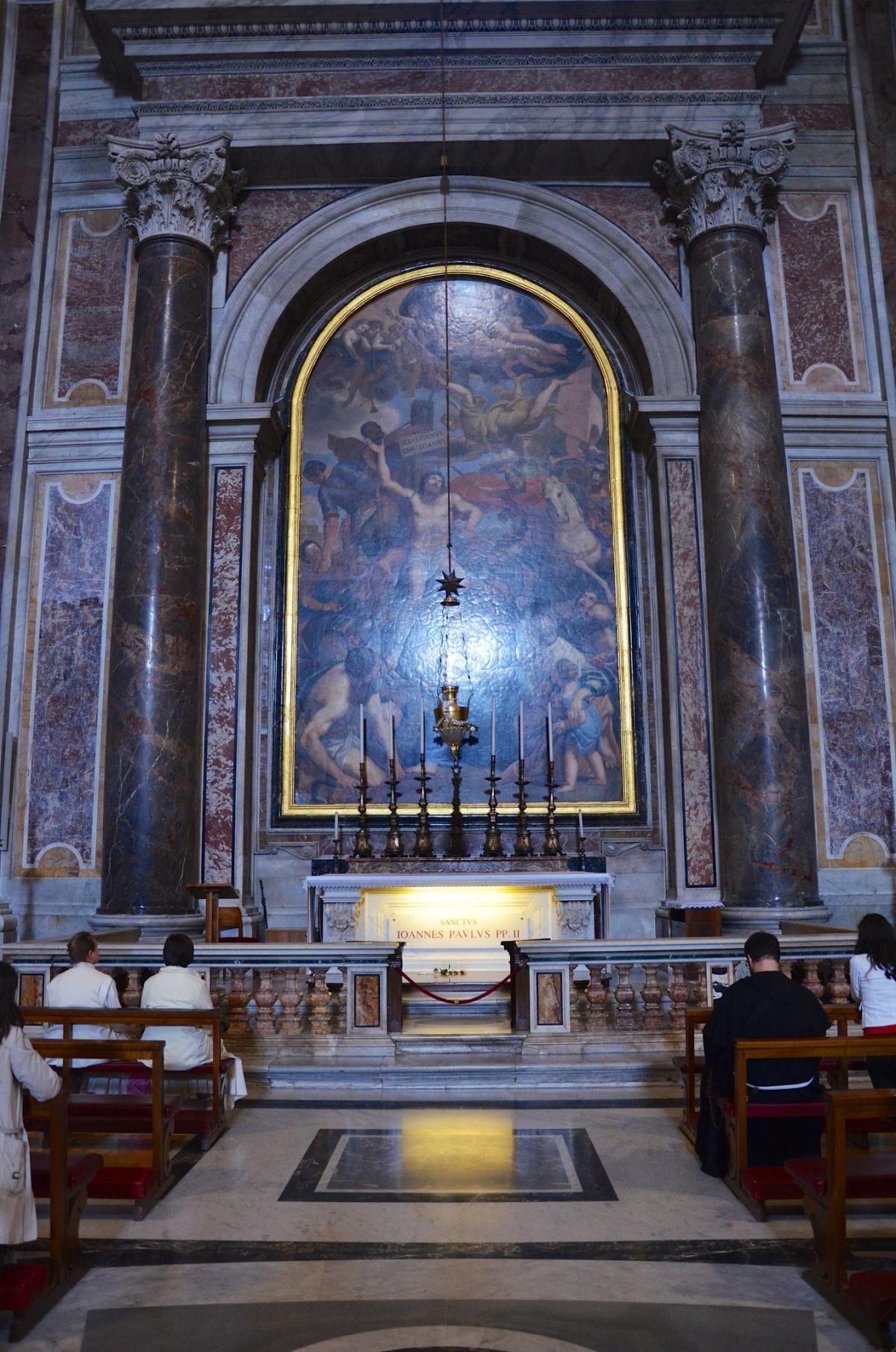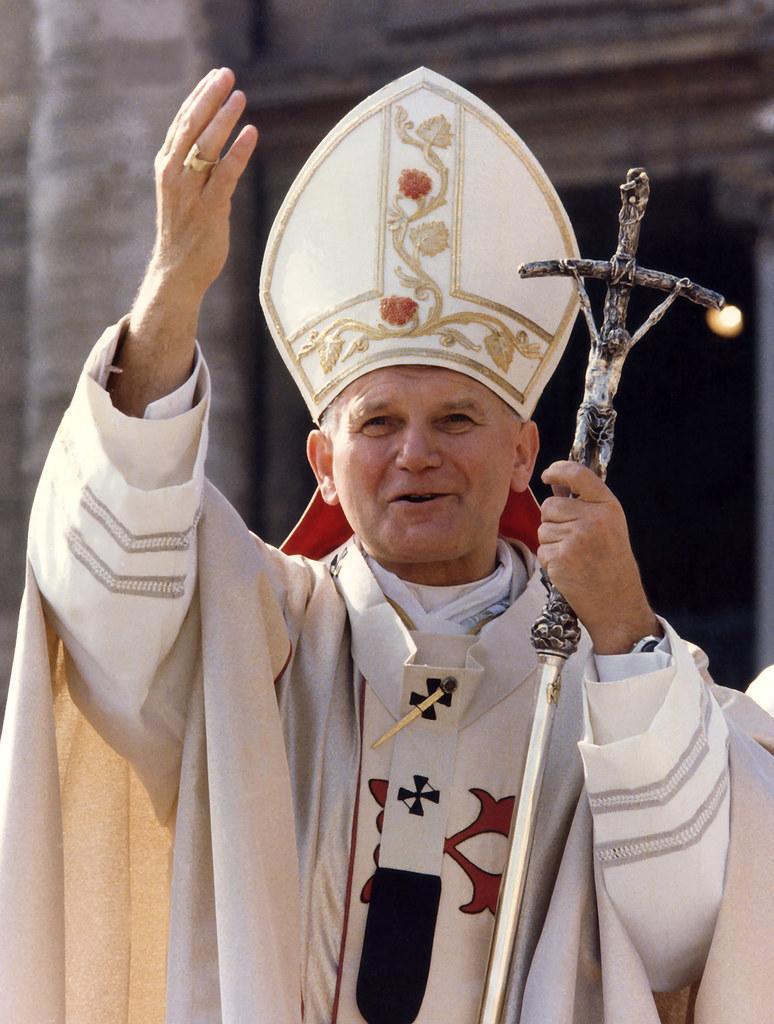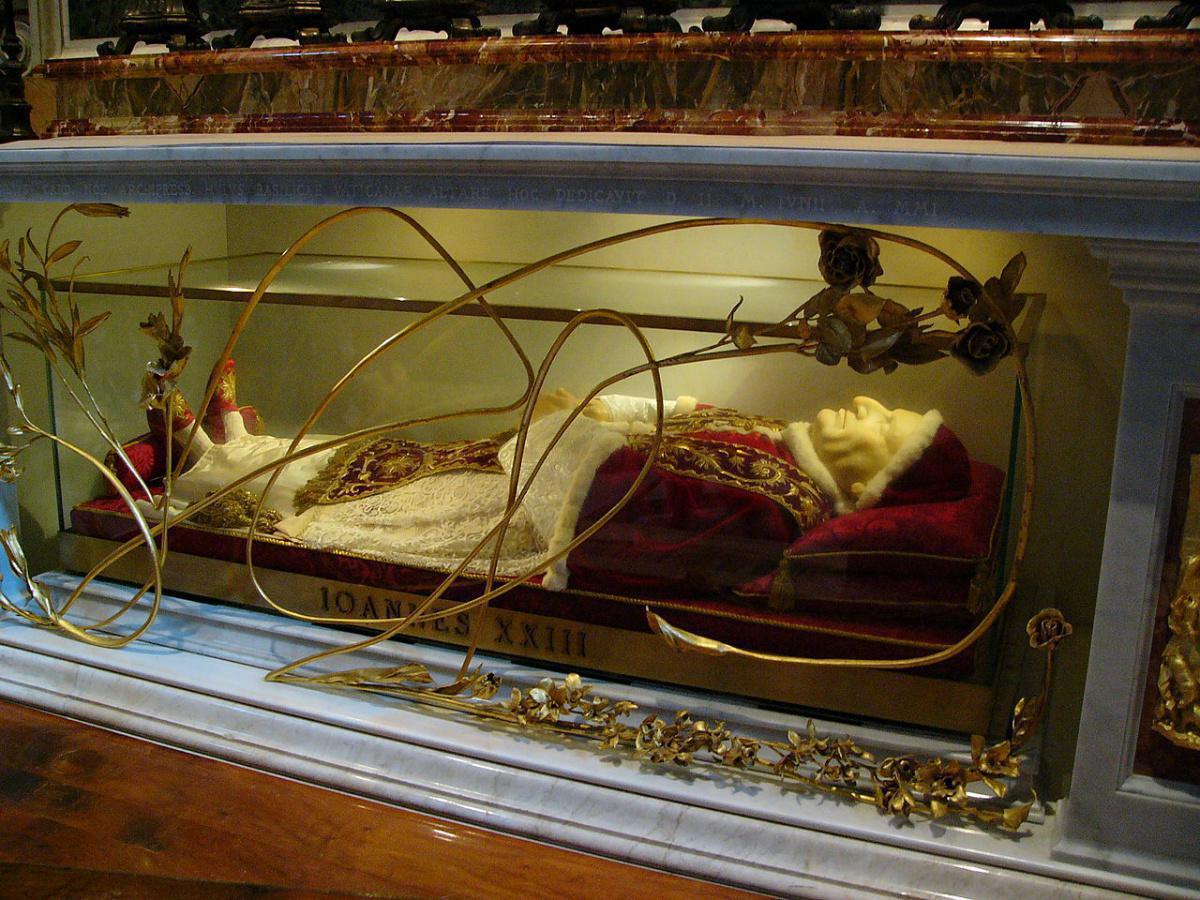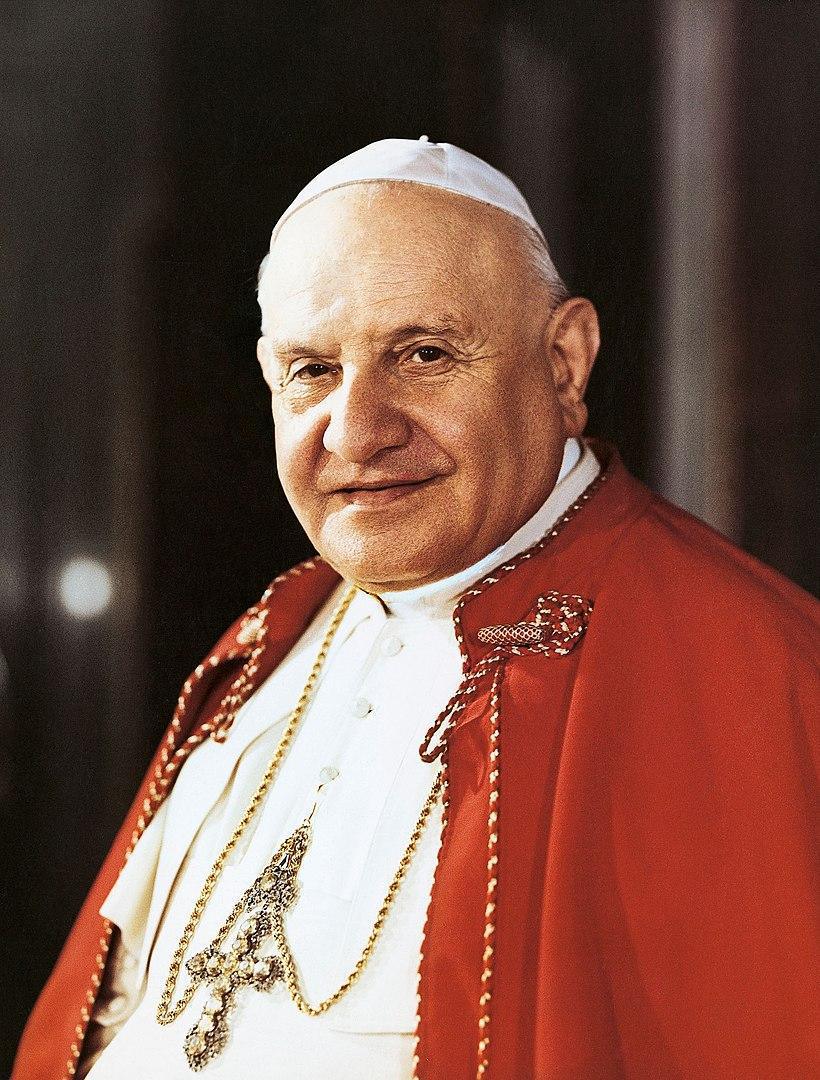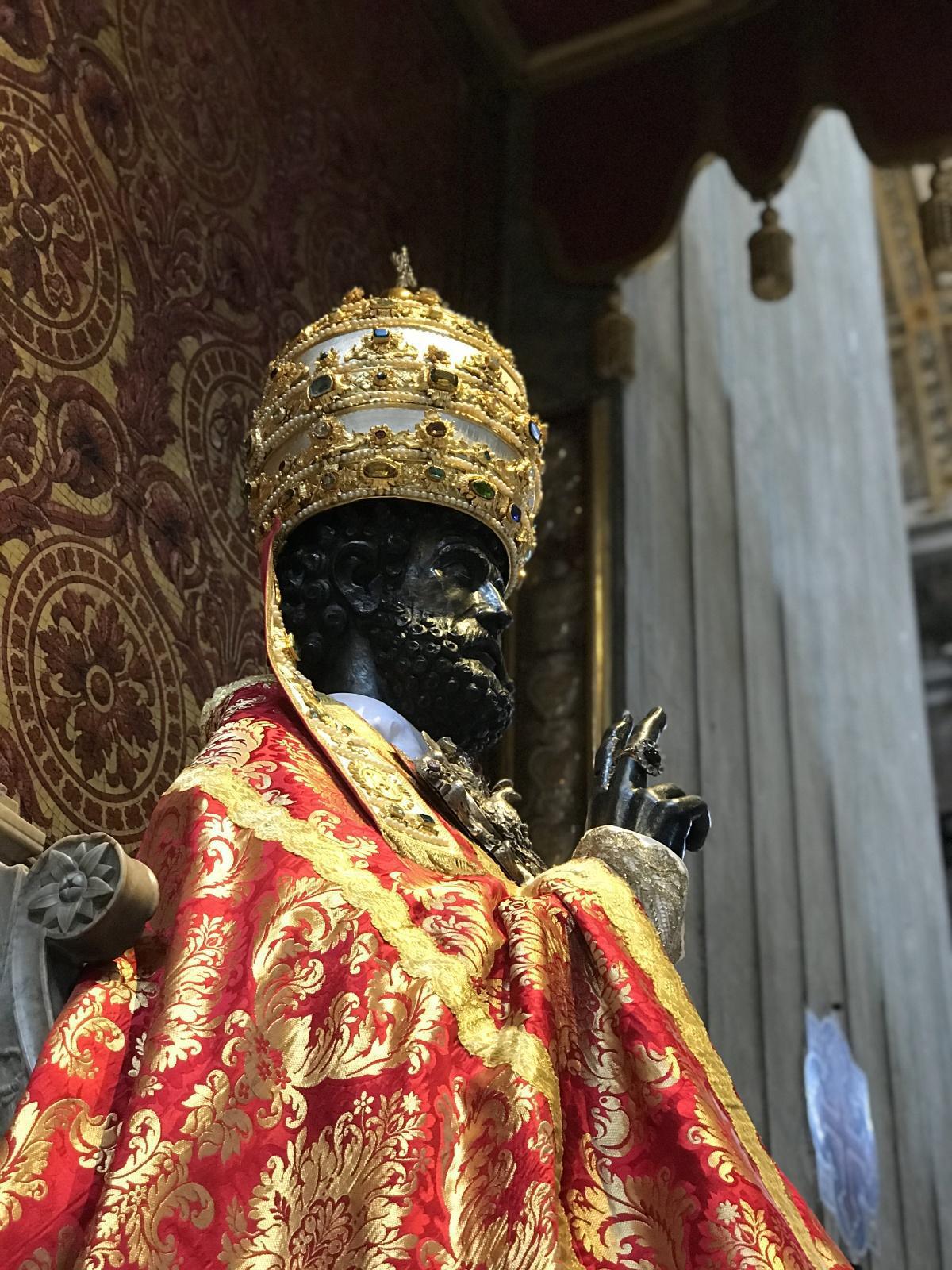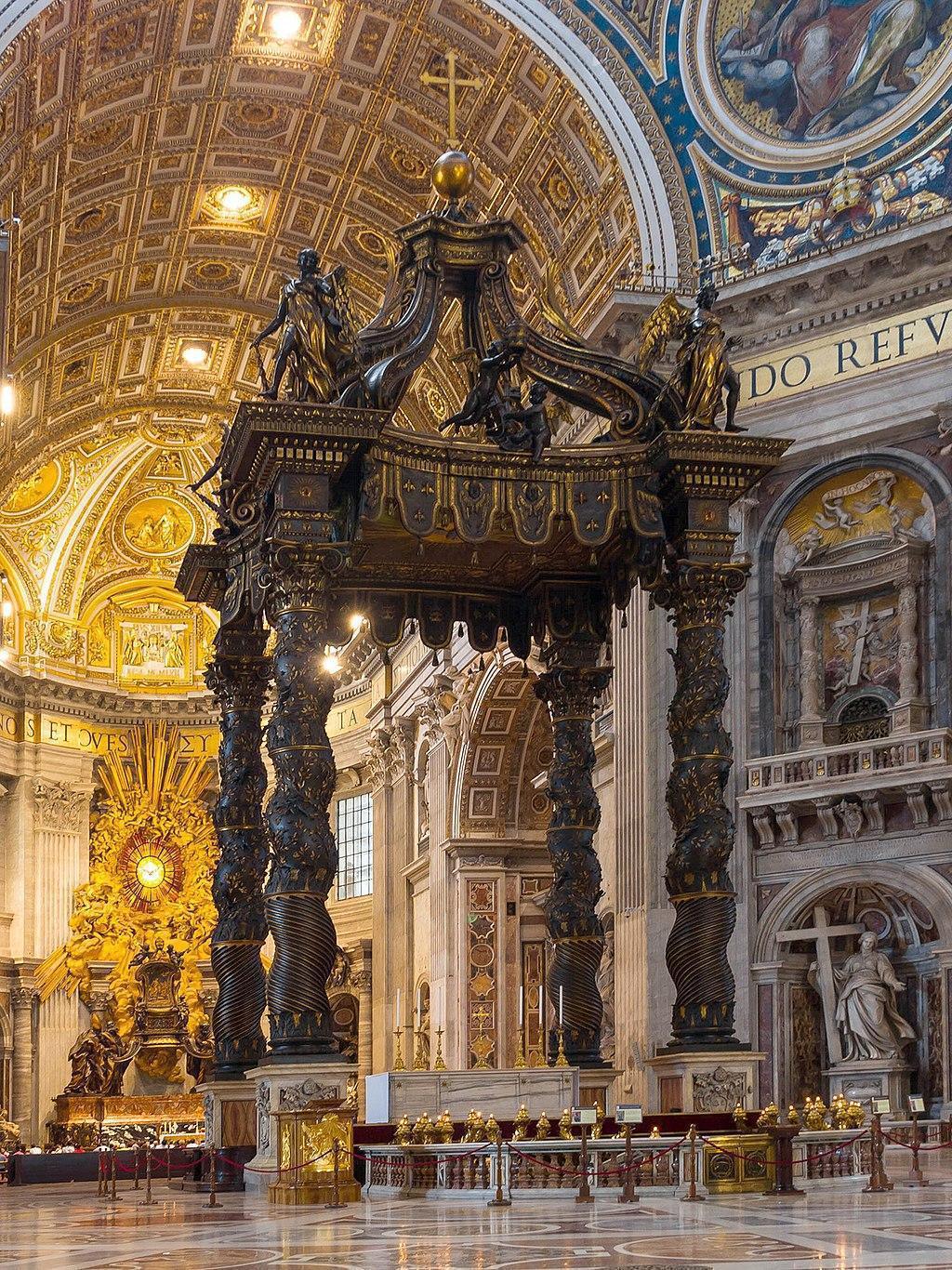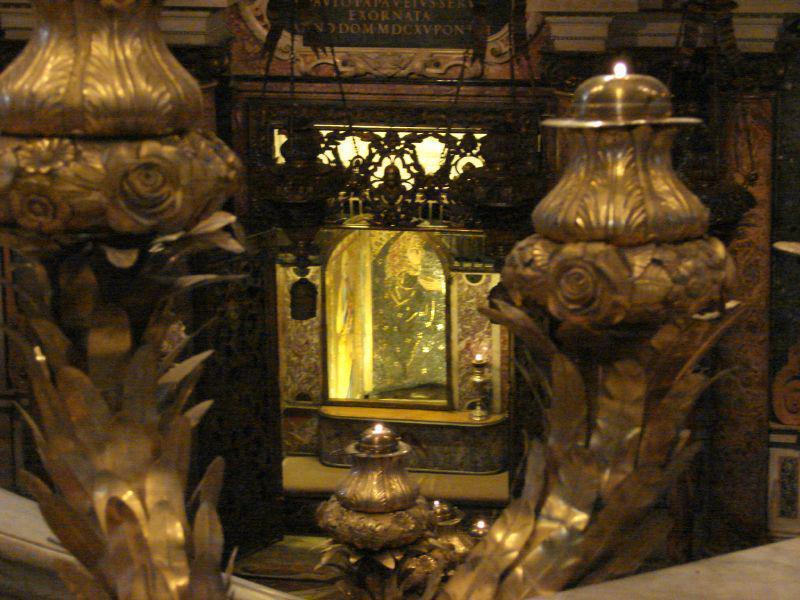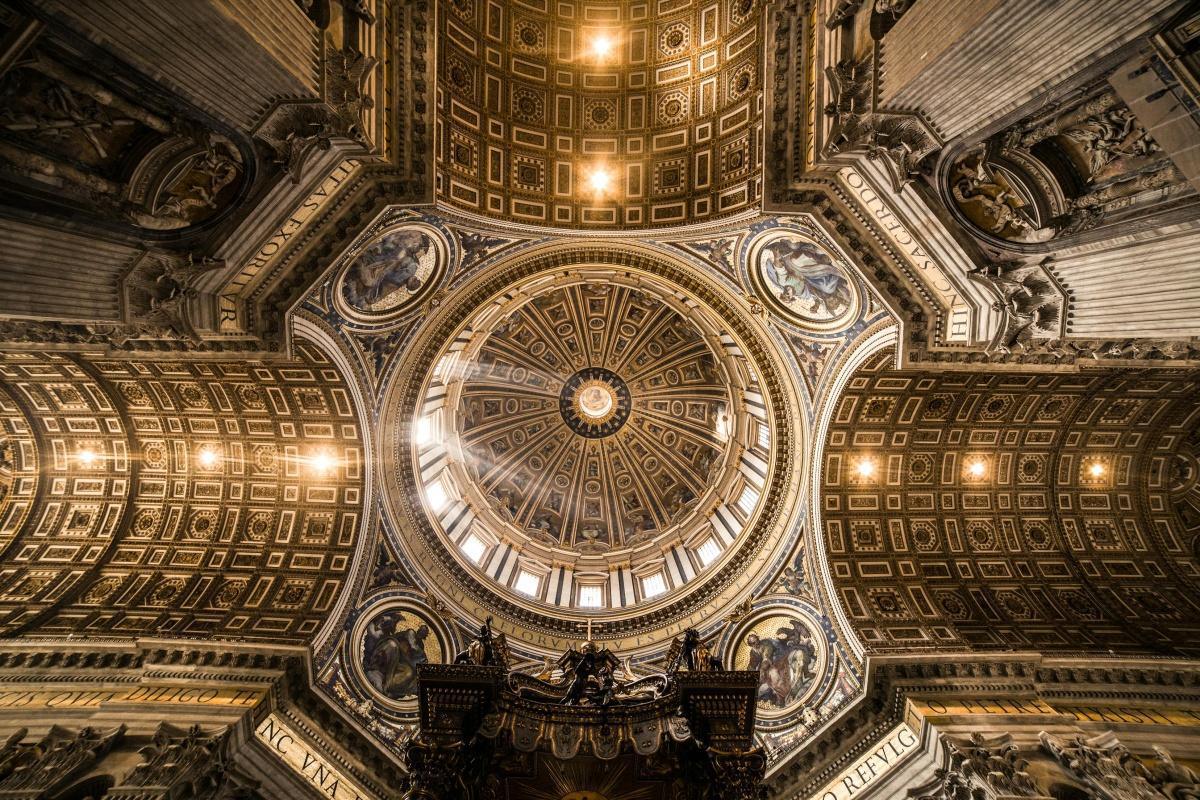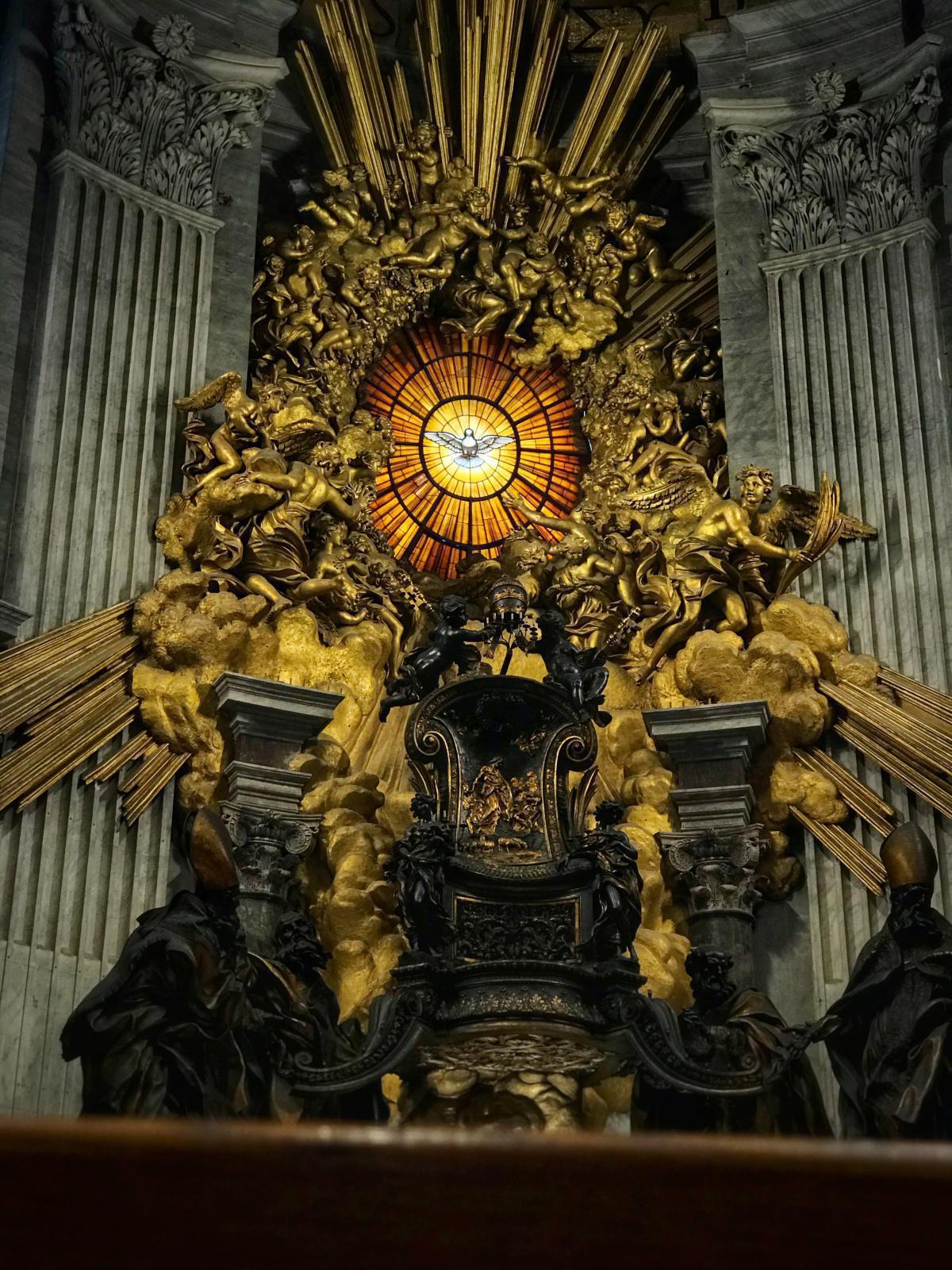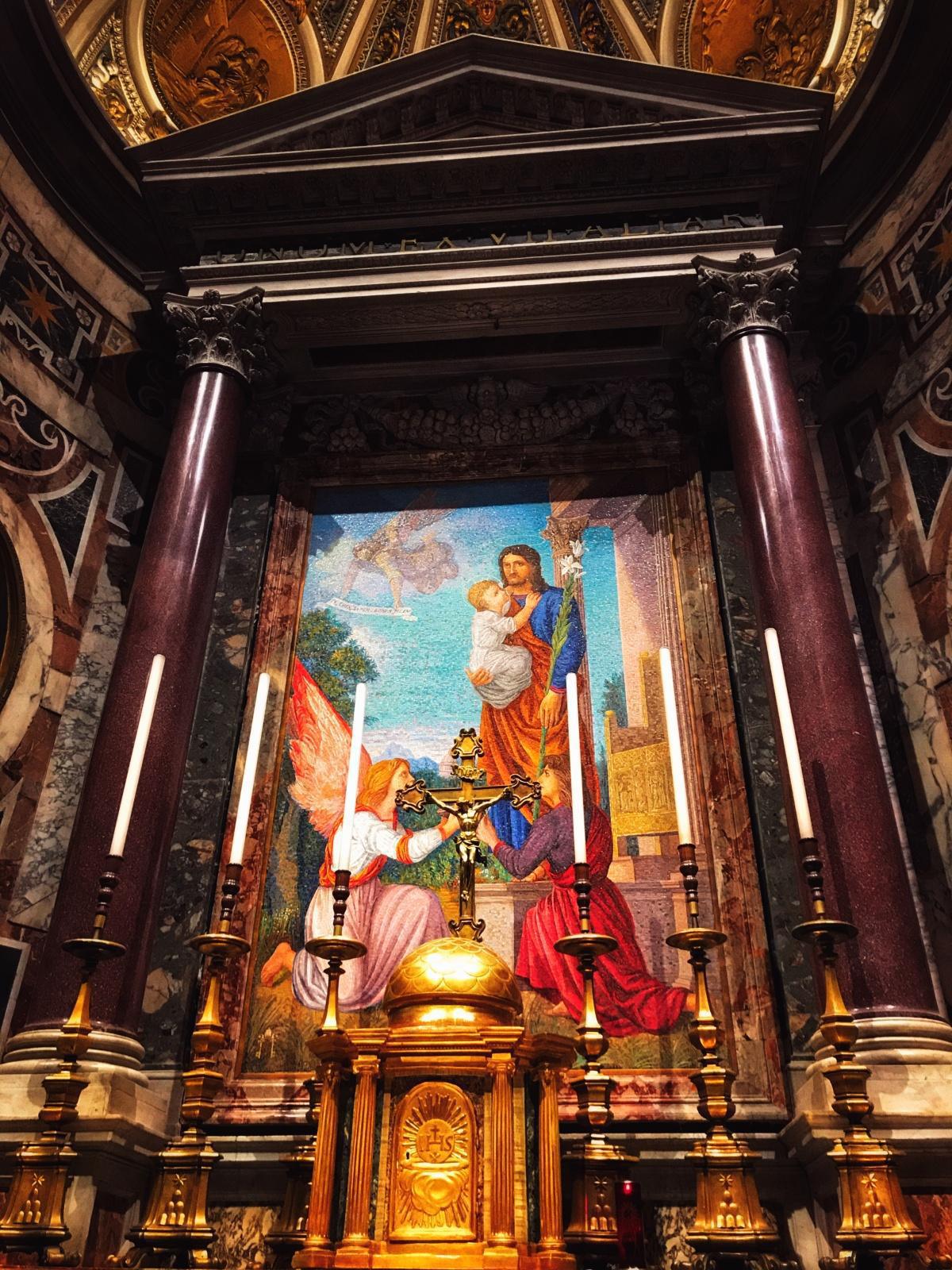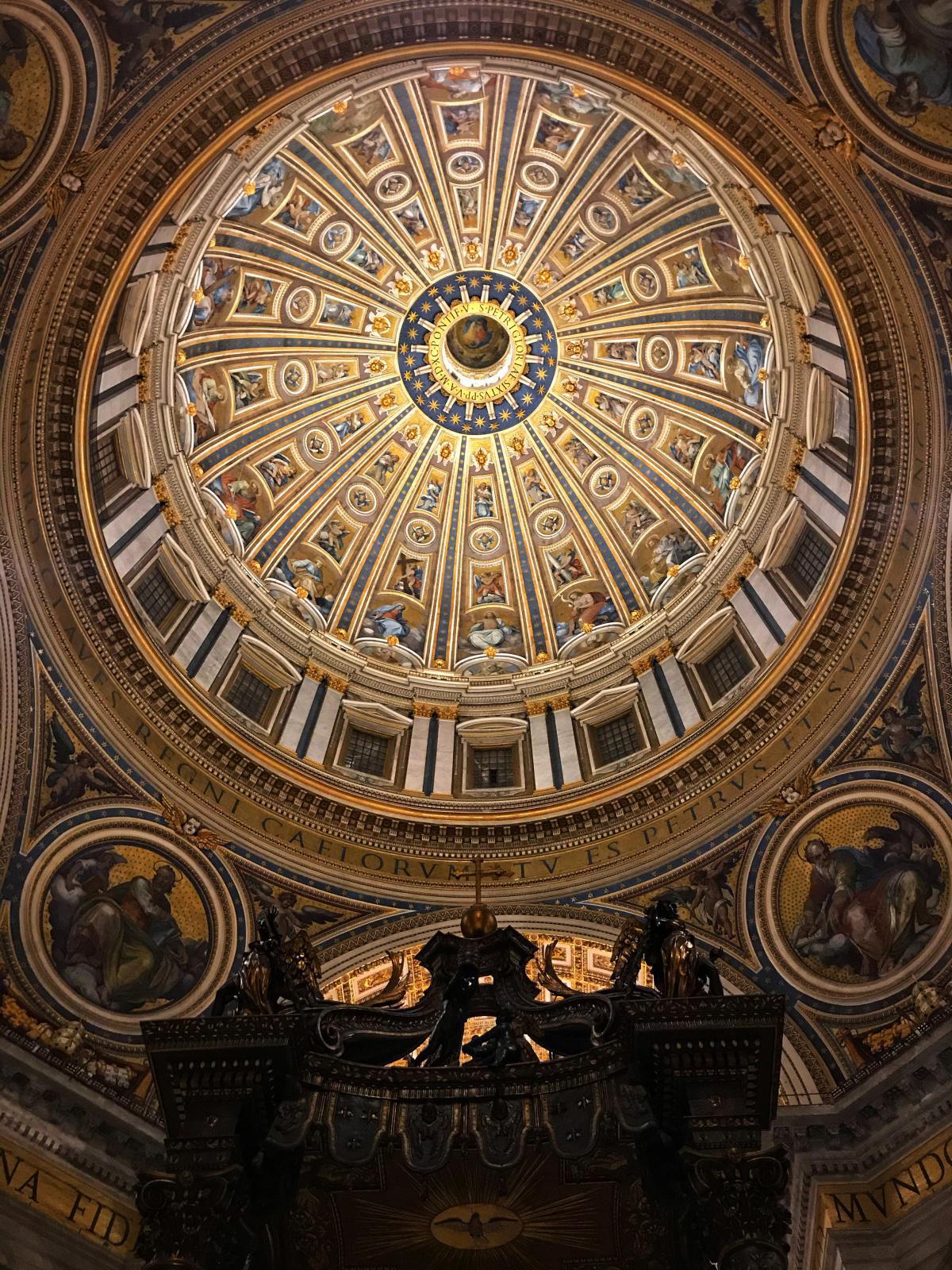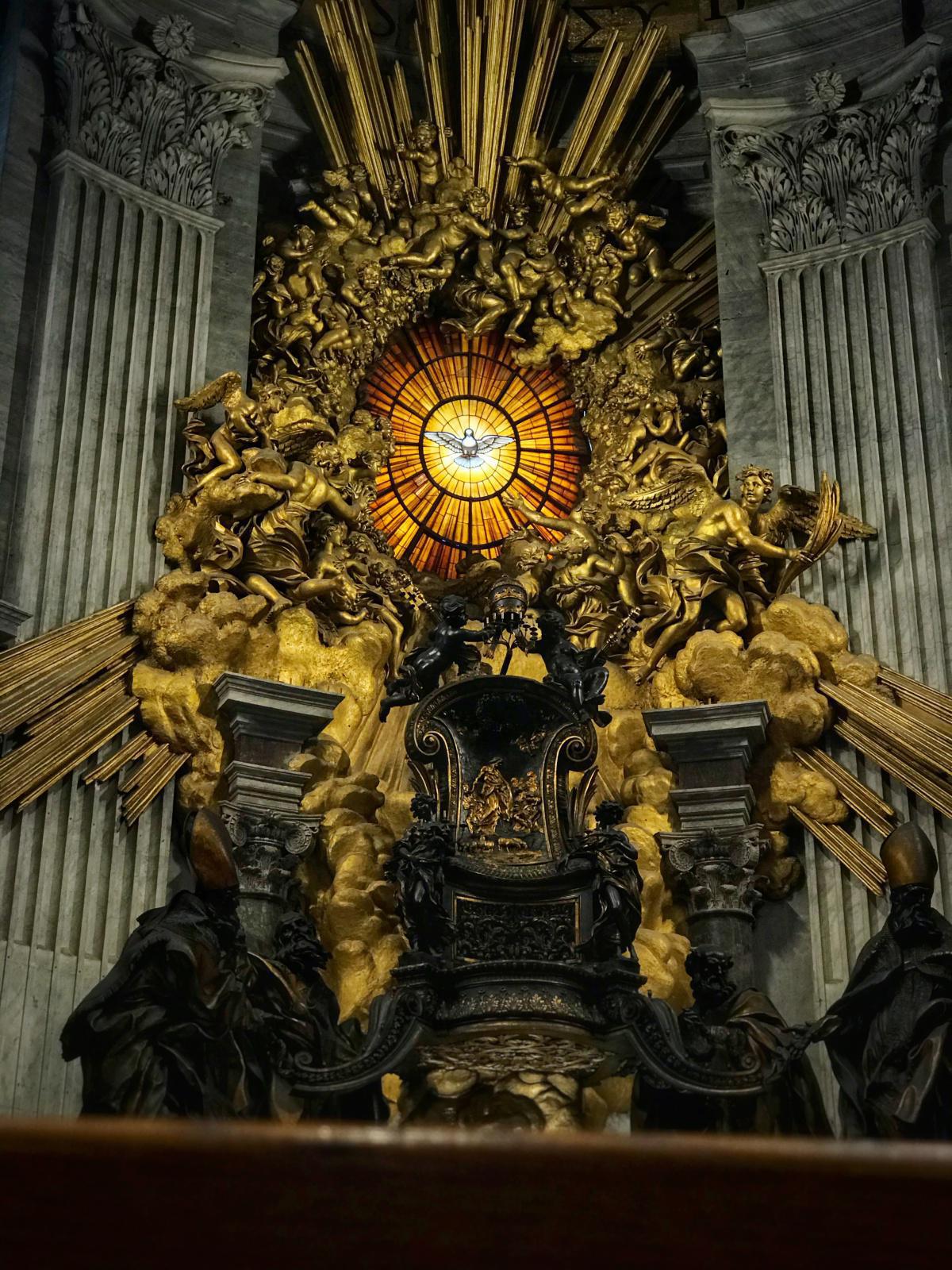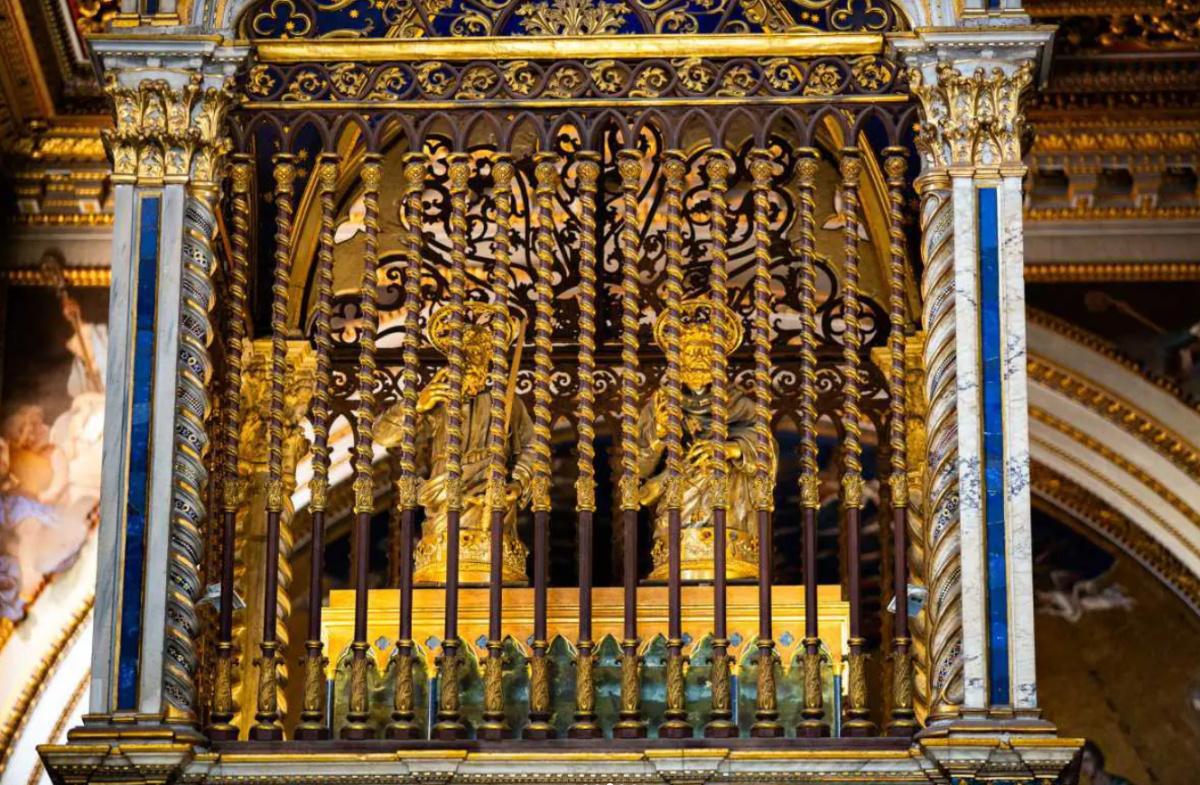
St. Peter's Basilica
Piazza San Pietro Città del Vaticano VA
Heart of the Catholic Church, Largest Basilica in the World, and Burial Place of St. Peter
Mass | Hours | Map
St. Peter's Basilica was built between 1506 and 1626, replacing the Old St. Peter's Basilica, which had stood on the site since the 4th century. The construction began under Pope Julius II and took over a century to complete, with contributions from renowned architects, including Donato Bramante, Michelangelo, Carlo Maderno, and Gian Lorenzo Bernini. The basilica was officially consecrated on November 18, 1626, by Pope Urban VIII.
Main Highlights:
La Pietà
Michelangelo Buonarroti carved the Pieta from a single slab of Carrara marble when he was 24-years old. The sculpture was unveiled in St. Peter's Basilica for the Jubilee of 1500.
The moving sculpture conveys the faith and emotion of the Blessed Virgin Mary as she cradles in her arms the dead body of her only son after witnessing him crucified.
The sculpture sits above a side-altar near the front entrance of St. Peter’s Basilica, where Mass was sometimes offered before recent restrictions. Visitors to the basilica can only see the Pieta behind bulletproof glass after a man attacked the sculpture with a hammer in May 1972.
The Pieta was the only work of art that Michelangelo ever signed.
Tomb of Pope St. John Paul II
At the altar of St. Sebastian are the remains of Pope St. John Paul II who was pope from October 16, 1978 to April 2nd, 2005. He was canonized on April 27, 2014. His body was moved from the Vatican grottoes to the main floor of St. Peter's in the days following his beatification in May 2011.
Born Karol Józef Wojtyła on May 18, 1920, in Wadowice, Poland, Pope St. John Paul II was the 264th pope of the Catholic Church, serving from 1978 to 2005. He was the first non-Italian pope in over 450 years and became one of the most influential leaders of the 20th century.
During his early life, he survived the Nazi occupation of Poland during World War II and was ordained a priest in 1946 and became the Archbishop of Kraków in 1964 playing a key role in resisting communist rule in Poland. His election as pope on October 16, 1978, marked a historic moment. As John Paul II, he strongly advocated for human rights, religious freedom, and peace, significantly influencing the fall of communism, particularly in Eastern Europe. In 1981, he survived an assassination attempt and later forgave his attacker, demonstrating his deep commitment to mercy and reconciliation.
Throughout his papacy, he became the most traveled pope in history, visiting 129 countries and reaching millions of people. He worked tirelessly to promote interfaith dialogue, strengthening relations between Christianity, Judaism, and Islam. His writings, including numerous encyclicals, shaped modern Catholic theology and addressed contemporary moral and social issues.
In his later years, he suffered from Parkinson’s disease but continued to lead the Church with resilience. He passed away on April 2, 2005, at the Vatican, prompting an outpouring of global mourning. Recognized for his holiness and impact, he was beatified in 2011 and canonized a saint in 2014 by Pope Francis. Today, he is remembered for his charisma, deep spirituality, and lasting influence on both the Church and the world.
Tomb of Pope St. John XXIII
The remains of Pope St. John XXIII are on display for the public to venerate. Orginally called Angelo Giuseppe Roncalli, he took the name John XXIII when he was elected pope in 1958. He served as pope until his death in 1963. He most notably commenced the Second Vatican Council, and was given nickname "The Good Pope". He was canonized by Pope Francis on July 5, 2013.
Pope St. John XXIII, born Angelo Giuseppe Roncalli on November 25, 1881, in Sotto il Monte, Italy, served as the 261st pope of the Catholic Church from 1958 to 1963. Often called the “Good Pope”, he was known for his humility, kindness, and groundbreaking vision for the Church.
Before becoming pope, he worked as a priest, Vatican diplomat, and cardinal, serving in countries like Bulgaria, Turkey, and France, where he built strong relationships with both Catholics and non-Catholics. He was elected pope on October 28, 1958, initially seen as a transitional leader, but he quickly made history by calling the Second Vatican Council (Vatican II) in 1962, a move that transformed the Church’s relationship with the modern world.
His papacy emphasized peace, social justice, and Church renewal. He wrote the famous encyclical Pacem in Terris (1963), calling for world peace and human dignity, especially amid the Cold War tensions. Despite serving for only five years, his impact was profound, and he was deeply loved by people worldwide.
John XXIII passed away on June 3, 1963, before Vatican II was completed, but his vision shaped the Church for decades. He was canonized a saint in 2014 by Pope Francis. Today, he is remembered for his warmth, openness, and desire to bring the Church closer to the people.
Bronze Statue of St. Peter
Dating to the 13th century, the statue depicts St. Peter holding the keys to the kingdom while also making a blessing. Tradition holds that it was sculpted by Arnolfo Di Cambio, the same artist who also as an architect designed the Duomo or Cathedral of Florence. Since its time in the Old St. Peter's Basilica, the statue bears witness to the dedication of pilgrims over the centuries. So many pilgrims have touched or kissed the foot of the statue that it has completely worn down. This tradition continues to this day.
On June 29th, the Feast of Sts. Peter and Paul, you can see St. Peter dressed in ornate papal vestments and wearing a papa tiara on his head. This feast day and the statue points to St. Peter's significance as the first bishop of Rome and to whom we can trace all the popes from one conclave to another.
The Baldacchino and Papal Altar marking the location of St. Peter's Tomb
At the heart of St. Peter’s Basilica stands the Papal Altar, located directly above the believed tomb of St. Peter. This altar is the central point for major liturgical celebrations led by the Pope. Made of white marble, it serves as a sacred focal point for worship within the basilica.
Covering the Papal Altar is the magnificent Baldacchino, a massive bronze canopy designed by Gian Lorenzo Bernini in the 17th century. Standing nearly 30 meters (98 feet) tall, the Baldacchino is supported by four twisting Solomonic columns, richly decorated with gold accents, intricate details, and bees—symbols of the Barberini family, to which Pope Urban VIII (who commissioned it) belonged. It was comissioned because inititallity St. Peter's Basilica was going to be shaped in the form of a Greek cross with the nave and transepts having equal length. After the nave was lengthened, pilgrims had difficulty seeing the place of St. Peter's tomb from afar. The Baldacchino resolved this problem making the focal point of the basilica noticeable for anyone upon entering the church.
Directly beneath the Baldacchino lies the Confessio, an area that houses the remains of St. Peter, the first Pope. Pilgrims can approach this sacred space, which is illuminated by the glow of 99 oil lamps, symbolizing their devotion to the Church’s foundation.
The Confessio: St. Peter’s Relics and a Mosaic of Jesus Christ from Old St. Peter’s Basilica
The Confessio is the sacred space directly beneath the Papal Altar and Bernini’s Baldacchino in St. Peter’s Basilica, marking according to tradition the burial site of St. Peter, the first Pope. It serves as a focal point of devotion, where pilgrims can approach and pray before the apostle’s relics. The space is illuminated by 99 oil lamps, symbolizing eternal faith and reverence. The name Confessio refers to Peter’s confession of faith in Christ, which led to his martyrdom.
St. Peter's Basilica in facts stands on the Vatican Necropolis, an ancient Roman burial ground. In the 1940s, Pope Pius XII authorized archaeological excavations that uncovered a first-century necropolis, confirming that St. Peter was indeed buried beneath the basilica. The discovery included a red wall (Muro Rosso), along with a Greek inscription reading "Peter is here" (Petros eni). Nearby, a hidden repository contained bones wrapped in purple cloth with gold thread, suggesting they belonged to someone of great importance. After scientific analysis, Pope Paul VI announced in 1968 that these relics were convincingly identified as St. Peter’s remains.
One of the most significant artistic elements of the Confessio is the 19th-century mosaic of Christ, which was originally part of Old St. Peter’s Basilica, built by Emperor Constantine in the 4th century. This mosaic, depicting Christ giving a blessing, was positioned above the original altar of Old St. Peter’s Basilica, symbolizing the connection between the ancient church and its grand Renaissance successor.
The Confessio not only represents St. Peter’s enduring presence but also serves as a powerful reminder of the Church’s unbroken history, from the time of Jesus and the Apostles, the martyrdom of the early christians after the Great Fire of Rome, and the legalization and promotion of Christianity by Emperor Constantine to our current age. The basilica is a testament to the unbroken continuity of the Catholic Church from generation to generation.
Cupola of St. Peter's Basilica: Largest Dome in the World & Michelangelo's Last Masterpiece
The cupola of St. Peter's Basilica was designed by Michelangelo to crown the basilica and mark the place of St. Peter's tomb beneath the Baldacchino and Papal Altar. It was completed in 1590, 26 years after Michelangelo's death in 1564. Michelangelo's credits the Pantheon as his work of inspiration for building the dome. It is also possible today to climb stairs inside the dome to go to the very top of the cupola.
The dome rises to a height of 136 meters (447 feet), making it the tallest dome in the world. It's began in the 16th century as part of the basilica’s grand rebuilding, replacing the original Old St. Peter’s Basilica. Michelangelo took over the project in 1547, refining earlier designs by Bramante and Sangallo. He strengthened the structure and based the dome on Brunelleschi’s masterpiece in Florence, but with even grander proportions. After Michelangelo’s death in 1564, the dome was completed by Giacomo della Porta and Domenico Fontana in 1590, following Michelangelo’s vision.
The interior of the dome is adorned with breathtaking mosaics, featuring Christ, Mary, the apostles, and angels. Just below the base, an inscription in Latin reads: “You are Peter, and on this rock, I will build my Church” (Matthew 16:18), emphasizing St. Peter’s significance.
Visitors can climb to the top of the dome, where they are rewarded with panoramic views of Rome and St. Peter’s Square. The dome’s grandeur not only represents the Church’s spiritual authority but also stands as a testament to Renaissance ingenuity and the faith of millions who visit each year.
Altar of the Chair of St. Peter's Basilica & Bernini's Holy Spirit Window
The Altar of the Chair of St. Peter is a wooden throne in Saint Peter's Basilica, encased in bronze by John Lorenzo Bernini, and given to Pope John VIII in 875. The stained glass window showing the Holy Spirit as Dove was also made by Bernini and was made out of alabaster.
At the far end of St. Peter’s Basilica, in the apse behind the Papal Altar, stands the magnificent Altar of the Chair of St. Peter, a masterpiece by Gian Lorenzo Bernini, completed in 1666. This grand Baroque structure was designed to enshrine the Cathedra Petri (Chair of St. Peter), an ancient wooden throne that, according to tradition, belonged to St. Peter, the first Pope. The relic is encased in a magnificent bronze structure, supported by the statues of four Doctors of the Church—St. Augustine and St. Ambrose (representing the Latin Church), and St. John Chrysostom and St. Athanasius (representing the Greek Church).
Above the altar, Bernini’s breathtaking Holy Spirit window dominates the apse. Made of gilded stucco and glowing amber-colored alabaster, the window features a radiant dove, symbolizing the Holy Spirit, at its center. The golden rays emanating from the dove create an ethereal effect, filling the basilica with warm light. This dynamic composition symbolizes the divine guidance of the Holy Spirit over the Church, reinforcing St. Peter’s authority and his successors’ role as leaders of the faith.
The Altar of the Chair of St. Peter is a focal point of major liturgical celebrations, especially on February 22, the Feast of the Chair of St. Peter, which honors the Pope’s role as the spiritual shepherd of the Catholic Church.
Altar of St. Joseph with Relics of the Apostles Sts. Simon and Jude
Alongside St. Peter, the relics of St. Simon the Zealot and St. Jude Thaddeus are venerated within St. Peter’s Basilica. Their tomb is located beneath the left transept, near the Altar of St. Joseph, where the apostles’ remains were placed after being transferred to Rome. Tradition holds that Sts. Simon and Jude were martyred in Persia while spreading the Gospel and were later brought to the Eternal City for veneration.
The Vaticano news piece on their relics explores the historical and spiritual significance of their presence in the basilica. The feature highlights the tradition of relic veneration, the apostles' missionary work, and the devotion they continue to inspire among the faithful. The documentary also delves into archaeological and historical evidence surrounding their relics, acknowledging other locations, such as Toulouse, France, and Armenia, where parts of their remains may also be enshrined.
Despite these varying accounts, their tomb in St. Peter’s Basilica remains a significant place of pilgrimage, emphasizing the apostles’ enduring legacy as witnesses to Christ. The relics of Sts. Simon and Jude, like those of St. Peter, connect the modern faithful with the very foundations of Christianity.
Prayer
Heavenly Father,
As I approach the majestic splendor of St. Peter's Basilica, I am filled with awe and reverence for the sacred history and faith it represents. May this visit be more than a journey through stone and art, but a pilgrimage of the heart, drawing me closer to You.
Within these hallowed walls, where countless faithful have gathered in worship, let me feel the presence of Your Spirit, guiding and inspiring me. May the beauty and grandeur of this holy place lift my soul to contemplate Your greatness and love.
As I stand before the tomb of St. Peter, Your apostle and servant, remind me of the strength and courage needed to follow Your call, just as he did. Grant me the humility to serve others and the faith to proclaim Your truth with boldness.
In this sacred space, surrounded by the prayers of saints and pilgrims throughout the ages, help me to deepen my own prayer and devotion. May this experience enrich my faith and renew my commitment to live for Your greater glory.
Through Christ our Lord, Amen.
Recommended Nearby:
Basilica of San Giovanni in Laterano
As the official cathedral of Rome and the seat of the Pope, San Giovanni in Laterano holds a status comparable to St. Peter’s. Its grand architecture, historical importance, and papal significance make it a key counterpart to the Vatican Basilica.
How to Locate the Bathrooms
There are two main restroom locations at St. Peter’s Basilica:
-
Inside the basilica, at ground level just before ascending the stairs, to the right of the main entrance.
-
Outside the basilica, on the right side of St. Peter’s Square, near the Vatican post office and the statue of St. Peter.
See Also:
Inside the Vatican - Special Access Virtual Tour
Located throughout Vatican City are places that require special permission to visit. In this self-guided itinerary, we will show you the best places to see.
Papal Basilicas Tour
Located throughout Rome, each papal basilica carries a rich story with many pilgrims to Rome making the journey to each one before choosing a favorite. By passing through the Holy Door of any of these basilicas, it is possibe to receive a plenary indulgence during the 2025 Jubilee Year.
Stay Connected:
Sign up and get weekly updates with new locations, itineraries and videos.
